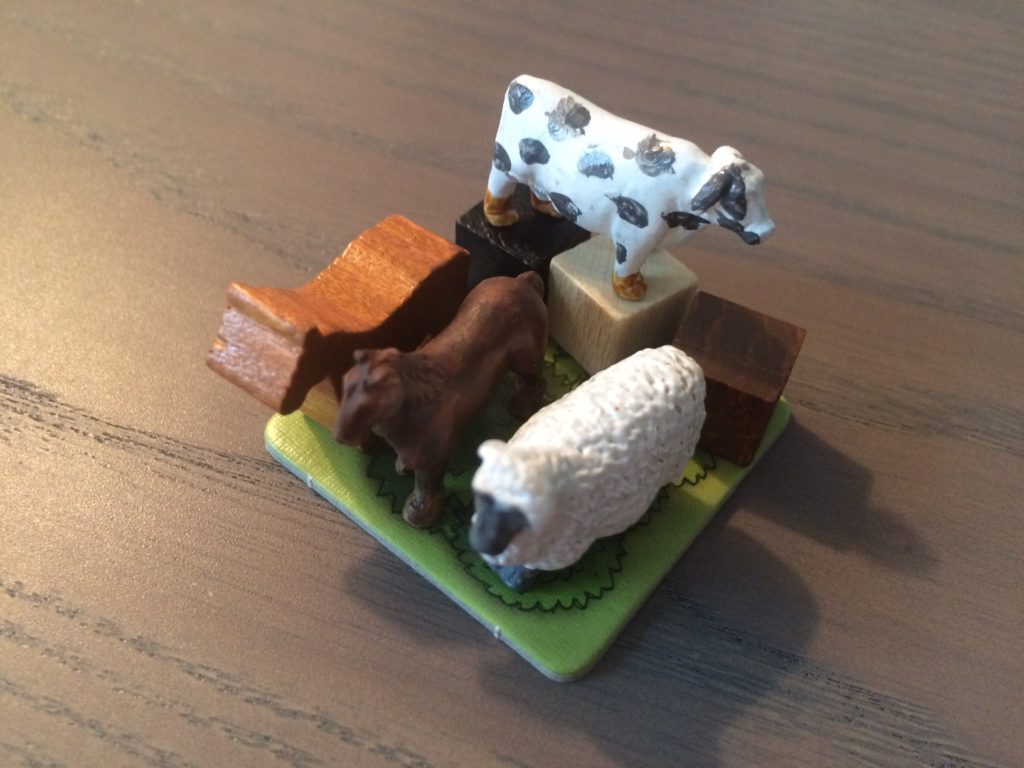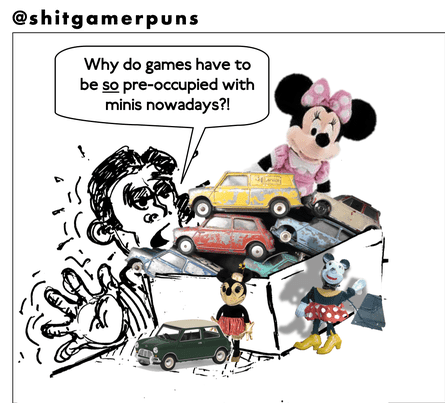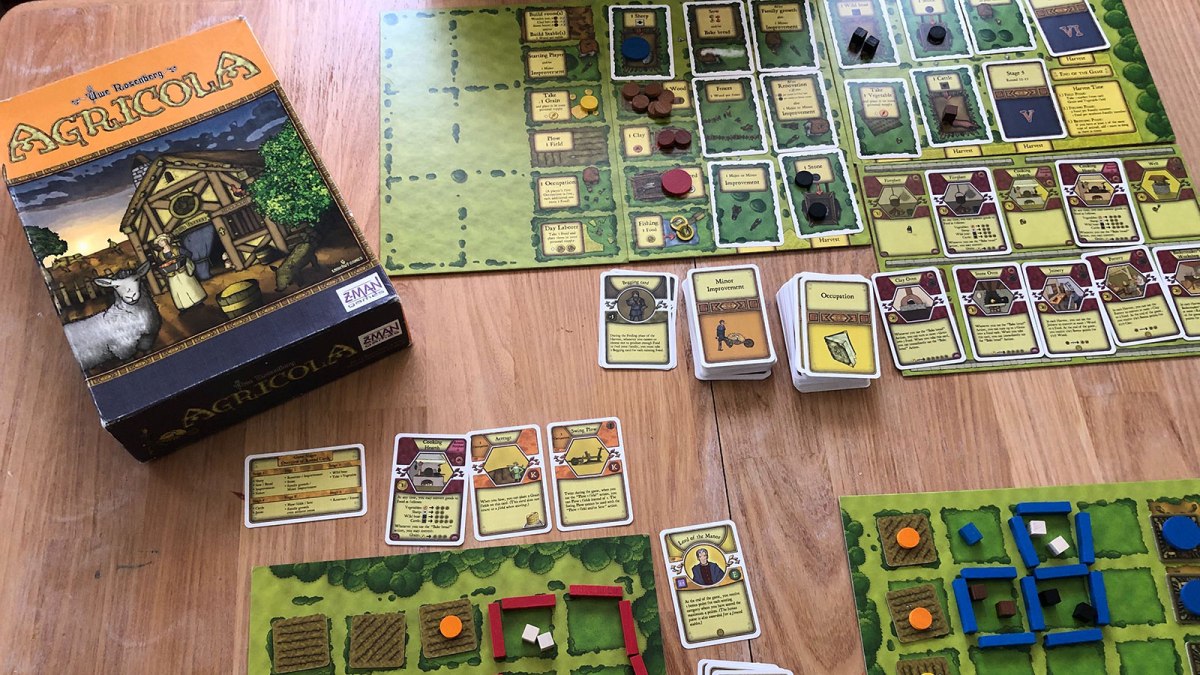Agricola: All Creatures Big & Small Wiki
So you've bought Uwe Rosenberg's masterpiece game Agricola. You've learned the rules, played several times, maybe even invested in upgrading your. Agricola means farmer in Latin, so no surprise that the game is about farming. The game is a standard worker placement game, so you send your works to do different farming tasks on the board. They can gather wood, plow, sow fields, get animals to raise, spend resources to build rooms, bake breads, etc. Agricola is the winner of countless board game awards as well as being ranked the 7 th best board game of all-time on BoardGameGeeks.com. The awards that Agricola has won include the 2008 Board Game of the Year and Best Gamer’s Board Game Golden Geek Award, the 2008 Spiel des Jahres (Germany) “Complex Game” Award, the 2008 Deutscher. Place the game boardin the middle of the playing area. Giveeachplayerafarm boardand place them such that theforestisatthetopandthepathisatthebottom. Lay out the 4 special buildings “Half-Timbered House”, “Open Stables”, “Shelter” and “Storage Building” next to each other. I’m a big fan of Agricola, because it feels more like a game of optimization rather than competition, and there are always several options you can take regardless of what others may do to try and block you.

We currently have 31 articles.
Please feel free to contribute by creating new articles or expanding existing ones.
Agricola: All Creatures Big & Small Wiki
We currently have 31 articles.
Please feel free to contribute by creating new articles or expanding existing ones.
Fences | Half-Timbered House |

Structures
Cottage
Fences
Stalls
Stables
Walls
Feeding Trough
Half-Timbered
Storage Building
Shelter
Open Stables
Stone | Reed |
Sheep | Cows |
- Competitive Animal Breeding Game 'Agricola: All Creatures Big & Small' Launching August 9th
- Uwe Rosenberg's Agricola Boardgame Review
We are currently maintaining 283 pages (31 articles)!
Recent changes | New pages | Missing pages

- How to help
- See how you can help contribute to the Agents of Mayhem Wiki! Remember to maintain a standard for grammar and punctuation in your contributions, please.
- Register
- Register an account to keep track of your contributions.
In Agricola: All Creatures Big & Small, the player is the owner of an old farmstead with a bit of land. However, a neighboring farmer happens to have a competitive streak -- so all bets are off! Both players (human and CPU) must use their wits to acquire and manage both resources and livestock over eight rounds -- while attempting to strategically deploy buildings -- in a mad dash for farm and fortune.
At its core, Agricola: All Creatures Big & Small is a competitive 1v1 ranch-themed board game. Like previous DIGIDICED releases Le Havre: The Inland Port and Patchwork, it supports cross-platform multiplayer worldwide -- allowing Android and iOS players to challenge each other based on their skill (and not which device they happen to own at any particular time).
What is Agricola: All Creatures Big and Small?
In Agricola: All Creatures Big & Small, the player is the owner of an old farmstead with a bit of land. However, a neighboring farmer happens to have a competitive streak -- so all bets are off! Both players (human and CPU) must use their wits to acquire and manage both resources and livestock over eight rounds -- while attempting to strategically deploy buildings -- in a mad dash for farm and fortune.
At its core, Agricola: All Creatures Big & Small is a competitive 1v1 ranch-themed board game. Like previous DIGIDICED releases Le Havre: The Inland Port and Patchwork, it supports cross-platform multiplayer worldwide -- allowing Android and iOS players to challenge each other based on their skill (and not which device they happen to own at any particular time).
The Farm
Farmhands
Victory Points
Agricola Basics
The Farm
Market Square
Farmhands
Victory Points
How to Play
Digidiced Website
Navigation
How to Play
Digidiced Website
Agricola Game Rules
Introduction
I’m a big fan of Agricola, because it feels more like a game of optimization rather than competition, and there are always several options you can take regardless of what others may do to try and block you. Quite often, trying to block another player simply puts you in a worse position overall… yet the trick is to block and optimize at the same time, which makes the game very interesting.
Below are some tips, discussing the game itself, goals to strive for, and some of the best choices you can make.
Quick Tips:
- Have an alternate move planned in case your choice is taken
- Wood is always useful
- Develop a source of food income
- Get a third worker ASAP
- Have a means of cooking livestock (Fireplace or Cooking Hearth)
- Try to take multiple actions at once
- Example#1: if taking Starting Player, also have the resources to play a minor improvement
- Example #2: If Building Rooms, also build 1-2 stables
- Example #3: If Renovating, try to also buy a major improvement (or at least a minor improvement)
- After Stage 3, aim for the most points with each worker action
- Aim for a diversified farmyard by late game
Aspects of the Game
Occupation Cards
If you are passing cards around instead of dealing a static set of cards to each player, try to choose cards that complement each other. With some exceptions, try to play no more than 2-3 Occupations total. Playing too many Occupations slows down your development in other areas. The cards are meant to boost your development, not BE your development. The more Occupation cards you play, the longer it takes you to catch up to those who played less cards.
Minor Improvement Cards
Similar to occupations, you’re looking for cards with synergy, and that go with your best Occupation cards. You should be playing minor occupations as part of another action, although taking Starting Player to play a minor improvement can make the action highly worthwhile if you’re continually late in the turn order and not able to use the best action squares.
Feeding your People with Livestock
One of the most important objectives in the game is to develop either crops or livestock such that they will feed your people without requiring a lot of workers to generate the food. The easiest way to do this is usually by obtaining a fireplace/cooking hearth, housing for at least 3 livestock, and at least 2 livestock of the same kind. With at least two livestock, they will breed after the harvest, “creating” 2-4 food per harvest (sheep=2, boar=2 or 3, cattle= 3 or 4).
The reason that livestock are an easier source of food is that they can be cooked at any time, although you cannot cook the newly-bred lambs, piglets, or calves to feed your workers immediately after they are born.

Feeding with Crops

Crops require a little more start-up time, more worker involvement, and (usually) some good cards. However, with the right cards, crops can score you a lot of points, cover up a lot of empty farmyard spaces, and generate a ton of food.
The most difficult part of using crops is getting your initial fields and grain without using a lot of worker turns, or having the “Plow” or “Grain” action squares repeatedly taken by others. This difficulty is overcome by having Occupations or Minor Improvements that grant grain or additional fields.
The trap with some cards, as they related to crops, is that they too have prerequisites that are difficult to meet early in the game, or that you won’t have enough cards that work well together, or that you’ll try to play too many cards and neglect other aspects of your farmyard.
You will also almost always want to grab an Oven major improvement, while having extra Grain to bake into bread upon purchasing the Oven.
Fields & Fences
Aside from the obvious purpose of holding crops or livestock, fields and fences are the best way to fill up your farmyard and eliminate negative points for empty spaces. Since existing fences can be used as a piece of wall for the next fence, you want to group your fenced area together. Thus, keep your fields and fences in separate areas of your farmyard. Certain cards may require you to plant fields adjacent to your rooms, so play accordingly, but ensure that you still have spaces available to build up to 4 rooms, and possibly more, depending again on your cards.
Building Rooms
When building rooms, it is very advantageous to also build stables at the same time, because you can do both with one action (although you may need more actions to gather more wood). Adding 2 stables before the end of Stage 1 or Stage 2, in addition to your “house pet”, allow you to breed two animals into three at harvest time. The advantage gained by doing this largely depends on whether Sheep was turned up as the first or second card. After that, Sheep usually just get grabbed by the person with the first fireplace, to be immediately cooked as food.
Family Growth
One of the most important steps you can take to get ahead of your fellow players is to add a third worker, thus boosting the number of actions you can take by 50%. If you grow your family on the same turn as a harvest, you only have to pay 1 extra food for the “baby”, which can be very helpful. However, if you grow your family earlier, you can have the use of that extra family member to gain food to feed all your workers. Thus, even if he has do take “Day Laborer” to get food to feed himself, there’s little penalty to having this worker. It can be somewhat risky, however, because aggressive players may grab all the food actions, forcing you to take a “begging” card, which loses you 3 points (which is a lot).
Resources
In general, try to gather more than 1 turn’s worth of resources with each action. That is, if you can wait until the Reed square has 2 reed on it, that’s a great time to grab it. Otherwise, try for the largest quantity of resources with each move. Even if that resource may not be your highest priority, as long as you can make use of it in the near future, more is better.
Wood
It is almost always a good idea to take 3 or 4 Wood with a worker when it’s available to you, unless you have a pressing need to do something else. Wood is used for a lot of improvements, in addition to the critical “building rooms” and “building fences”.
Clay
Agricola Board Game Rules
The most frequent use of clay is for improvements, but with certain numbers of players, the extra clay generated by the action cards could make clay abundant enough to be used to build rooms following an early renovation to clay hut. Taking clay early allows a player to have a chance at the cheapest (2 clay) Fireplace, which then usually permits one to also take and cook sheep quite early. However, if clay is abundant, try to get 4 clay with one worker action, and buy a Cooking Hearth instead, as it will make Boar, as a source of food, much more useful to you later, as each boar will give you three food instead of two.
Agricola Game Rules
Stone
The black rock is used mostly for major improvements, and of course the Stone Hut. The most commonly grabbed major improvements that involve stone are usually the Clay Oven, or the Well, as both are worth points and give other benefits.
Reed
Agricola Board Game Rules
The best time to grab reed is when you can get it and another resource at the same time. Failing that, try to take reed when you can get multiple reed at once. Reed is only used for building rooms, renovations, and for the basket-maker major improvement. While reed can be very important and even critical, you don’t want to have any more of it than you need for immediate use.